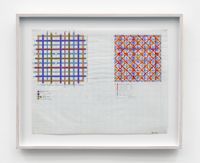
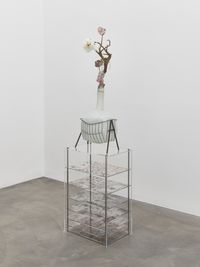
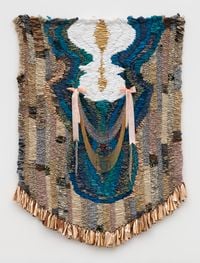
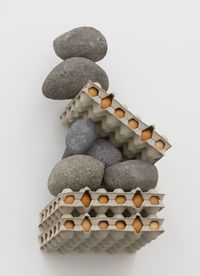
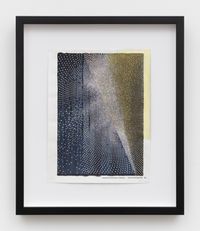
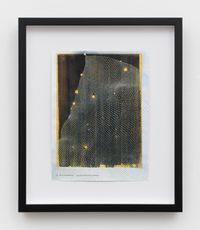
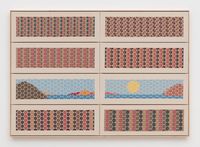
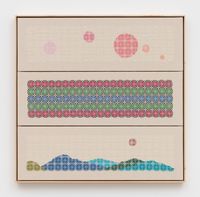
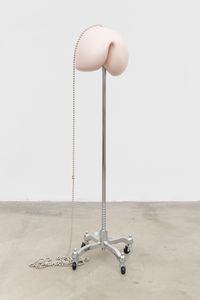
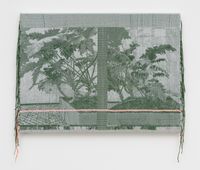
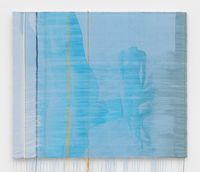
This exhibition took place at our previous Culver City location.
Anat Ebgi is pleased to announce a group exhibition Variations on a Theme, featuring works by Gloria Klein, Jesse Krimes, Suchitra Mattai, Theo Mercier, Linn Meyers, Jordan Nassar, Meeson Pae, and Mia Weiner. The exhibition will be on view from June 24 through August 5 at 2660 S La Cienega Blvd. An opening reception will take place at 2660 S La Cienega Blvd, Saturday June 24 from 3–6pm.
Looking at an intergenerational selection of artists, Variations on a Theme examines artistic practices which utilise structures and systems as their primary approach to art making. Self-created, complicated, and varied parameters encourage results beyond imagination—invoking improvisation, entropy, and spontaneity. These processes often challenge conceptual notions of meaning and representation, relinquish authorial control, and allow artworks to emerge organically as consequences of sets of rules.
Variation, modulation, deviation—breaking from a pattern can reinforce the steadiness of rhythms and the rigidity of structures. As such, the turns, breaks, and slippages in the exhibition expose inherent limitations of visual language and highlight subjectivity of interpretations. Creators of their own universes, working in a system allows artists to take the unassertive an ordinary, such as a colored stripe, a round stone, or a google image search and transform it into something full of energy and surprise.
The work of Gloria Klein (1936–2021) uses self-developed systems and processes to experiment with palettes and compositions that result in intricate patterns ranging from the highly structured to the completely chaotic and every variation in between. The interplay of order and disruption plays a vital role in Klein's practice, who came of age in 1970s New York. Her slender hard-edged hatch marks of varying lengths were core to her paintings and drawings. Like a single sewing stitch only makes one mark, collectively hundreds and thousands of them create intricate patterns and complex compositions.
Relinquishing control to Google image search algorithms, Jesse Krimes' (b. 1982, Lancaster, PA) sculptures expose hidden systems and networks. Krimes begins with the search terms, 'beauty' and 'decay' printing the results exactly as they appear, onto transparent trays, each one a digital archeological site, a toxic soil sample of contemporary society. His work investigates the circulation of these images through news and popular media that produce and reinforce stereotypes and beauty standards not reflected in the real world we live in. Krimes uses participatory art practices that traverse prison bars and the urban and rural divide. Alongside his art practice, he is the co-founder of Right of Return USA, the first national fellowship dedicated to supporting formerly incarcerated artists.
The creation ofSuchitra Mattai's (b. 1973 Guyana) kaleidoscopic sari tapestries involves traditional domestic labor techniques such as weaving and embroidery. As crafts these techniques are guided by foundational structures of logic, order, and repetition. Through manipulation of the elemental stitch one can find room for expression and individuality. Expressive of her identity as an Indo-Caribbean artist, they are made from a mixture of everyday found materials such as feather boas, fabric, beads, and rope, and legacy materials such as ghungroo bells, prayer Dupattas, and her mother's vintage saris, which embed cultural and familial meanings. Though fundamentally abstract, Mattai weaves these materials into mass produced gridded net structures, mobilising her forms to address topics such as the legacy of colonialism, immigration, labour, borders, and political narratives around caste systems and social classes.
As a true autodidact, **Théo Mercier **(b. 1984, Paris) has claimed great formal freedom since the beginnings of his art practice. The sculptures in this exhibition comprise large stones resting on stacks of eggs nested in protective cardboard crates. These found precarious structures allude to an avowal and disavowal of protective systems: the hard but fragile shell of the egg, the soft but ultimately secure egg cartons. Mercier's works impose paradox, strangeness and humour as visual points of view, resulting in a sprawling practice including sculpture, performance, plays, film, and installations. Drawing his raw materials 'from the world,' that is from ordinary life, his works lead to reflections located at the crossroads of anthropology, geopolitics, and tourism. Mercier is a collector and creator; oscillating between authenticity and choreography, he explores themes of cultural obsolescence, artifice, and mechanisms of history.
**linn meyers **(b. 1968, Washington D.C.) makes meticulous drawings that hinge on the unique and imperfect quality of the hand-drawn line. Her works are manifestations of human movement through repetitive sequences of dots and lines. meyers welcomes the slippages that occur with the slightest involuntary movements of her body and the delicate patterns that emerge over time. Her practice explores ideas of impermanence, as many of her labor-intensive wall drawings are ultimately painted over, leaving only the documentation or memories of the work. In this way, the artist's works on paper become even more central to her practice, emphasizing their presence and objecthood.
Exploring heritage and homeland through various mediums, Palestinian-American artist **Jordan Nassar **(b. 1985, New York, NY) has rooted his artistic practice in traditional levantine craft forms. He adapts Palestinian tatreez embroidery (a patterned geometric cross-stitch) to reflect his hybrid upbringing and collaborates with craftswomen in the West Bank to create contemporary works. A self-taught artist, Nassar's embroideries juxtapose regional motifs with imagined landscapes in a way that breaks with and expands upon the thousands of years old tradition. His practice is rooted in a linguistic and geopolitical field of play characterised both by conflict and unspoken harmony. Although Nassar continues to work within the inherent gridded structure of his embroidery cloth, the pieces for Variations disrupt structure by expanding the landscapes and symbolic patterns across multiple panels.
Drawn to the visceral, Meeson Jessica Pae (b. Indianapolis, IN) explores interiors of the body as sensual architecture and machine, where fleshy soft bits and bodily fluids undulate and transform into otherness. The machine/body distinction is complicated further through her process. With the assistance of computer generated systems, Pae renders her compositions in three dimensions before painting them on canvas. Her imagery oscillates between representation and abstraction, micro and macro, biological and mechanical. Pae's fluid gestures and undulating forms are used to create entangled, mysterious, asymmetric compositions where fleshy folds, dripping refractions of bodily fluids, and mechanical machine components create relationships and function symbiotically.
Mia Weiner (b. 1991, Chicago, IL) weaves monochromatic tapestries based on her own photographs. Her imagery begins by considering slight physical sensations such as the feeling of a knee crossed over a leg, a deep breath, or what it feels like to float in water. Pictorially, Weiner's work disrupts stable network relationships such as plant systems (stems/leaves), muscle relationships (head/neck), or elementals (land/sea/air). Although she works with a digitally assisted jacquard loom, guided by intuition, Weiner retains her ability to make adjustments to color or yarn, manipulate tension, or insert odd materials into the weavings resulting in a collaboration between human and computer.
Press release courtesy Anat Ebgi.
2660 S La Cienega Blvd
Culver City
Los Angeles, 90034-2604
United States
anatebgi.com
+1 310 838 2770
The gallery is temporarily closed until further notice.
Tues - Sat, 10am - 5pm